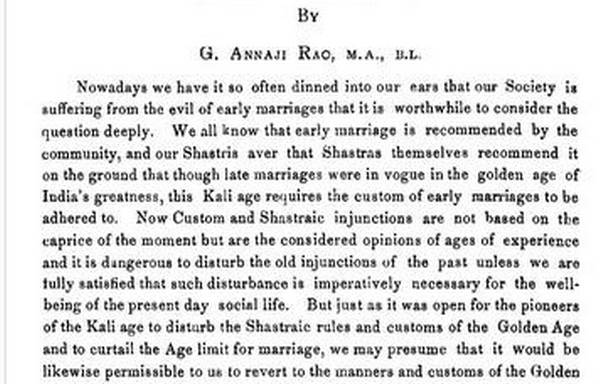ART NEWS
Going beyond the symbolic
Gulvadi Annaji Rao exposes the weaknesses of the orthodox Brahmin religionists as well as those that call themselves social-reformers
Gulvadi Annaji Rao‘s Rohini illave Saraswatha Mandala was published in 1906 in Calicut. Except for a substantial analysis of Rohini by U. Maheshwari in her book, Idu Manushiya Odu (2001), there is not much on Rohini in the few books that are available on the Arunodaya period. Rohini continues to stay hidden, though its existence is not in question. According to A Catalogue of The Kannada, Badaga, and Kurg Books in The Library of The British Museum compiled by L. D. Barnett, a copy of Rohini is available in that library. This article on Rohini is put together using all these secondary sources, especially U. Maheshwari’s analysis.Like Gulvadi Venkata Rao, author of Indira Bai, Gulvadi Annaji Rao too belonged to the Chitrapur Saraswat community. As he sets about painting a much broader landscape of the community in Rohini, Annaji Rao exposes the weaknesses of the orthodox Brahmin religionists as well as those that call themselves social-reformers, but he is particularly concerned about reforming his Saraswath community and talks about creating an alternative model.Rohini is the daughter of Mukunda-raya, social-reformer and member of Brahmo Samaj. Her mother, Sunanda Devi follows orthodox Brahmin customs. Rohini goes along with her mother to temples and purana recitals, and with her father to the Upasana Mandir. In a sense, she has no say in these matters. Rohini is 14 years old and her mother wants to get her married to a Brahmin boy of their own community. But Mukunda-raya believes in adult marriage according to the tenets of the Brahmo Samaj. Her mother is scared of Christianity and instead of sending her to a girls’ school, she herself teaches Rohini at home. But her mother’s wishes are thwarted and her father gets Rohini married to a social-reformer named Amrita-raya in the Brahmo Samaj tradition.Amrita-raya drifts into the orbit of Vishweshwara-raya, known as ‘Sudharakagrani’ ‘Leading Reformer,’ falls into bad ways and ends up as a drunkard. Vishweshwara-raya is actually a cheat in the garb of a social-reformer. Amrita-raya regrets his ways in front of Rohini, but abuses her when she questions him. But she is patient throughout. Once when he beats her up, she faints and a frightened Amrita-raya also collapses, faints and is paralysed. Rohini takes care of him, but he does not recover, he dies. Rohini becomes a widow.A number of young men and women play important roles and take the novel forward through their beliefs and statements. Sanjiva-raya, who belongs to the orthodox Brahmin group, says, “a proper Brahmin wife must accept her husband’s religious views as her own.” Marutha-raya, who believes in social-change, is ostracized from the community because he could not pay the fine amount imposed on him. Bhaskara-raya comes forward to help Marutha-raya during this period. Marutha-raya had offered shelter to Mithra, daughter of Vishweshwara-raya, the fake reformer. Marutha-raya had looked after Mithra all these years and he fears that if she goes back to Vishweshwara-raya, she might be forced to convert to Christianity or Islam. Bhaskara-raya is attracted towards Mithra, but when he realizes that she is Vishweshwara-raya’s daughter, he starts avoiding her. Vishweshwara-raya, who had deceived a lot of people, is finally caught and arrested due to the efforts of Mukunda-raya, who also brings Marutha-raya’s family under his care. Rohini and Mithra become friends against this backdrop. Mithra is saddened by the fact that Bhaskara-raya looks at her with contempt, but there were other reasons for her misery. Whenever she wore good clothes or jewels or smiled and laughed while speaking with people, her grandmother would chide her – “childhood is for boys, not made for girls.” She must dress like a married woman of 30 even if she is only seven years old, must not sing, must not adorn herself – because only prostitutes do such things, her grandmother would say. Mithra could not understand any of these rules. Mukunda-raya is now thinking seriously about Rohini’s remarriage, but her mother is against the idea. Narayana, Mukunda-raya’s nephew, is secretly in love with Rohini. He was deeply hurt when Rohini was married to Amrita-raya. He is still attracted towards Rohini, but now that she is a widow he wants to be mentally distant from her. She is aware of Narayana’s feelings towards her, and she too likes him but is helpless. Her despair comes through when she says, “What if women have beauty? What if they are from respectable families? These selfish men have created these cruel customs and have sucked the soul out of the lives of women.” Narayana wants to marry Rohini, but holds back. He feels that she is a ‘para-stree,’ a woman who was married to someone else. Narayana is a progressive young man and marrying a widow is not against his worldview, but he hesitates. Ramasharma tells Narayana that Rohini is a widow now and not a ‘para-stree’ anymore and that he would be doing a virtuous deed by marrying a widow. This Ramasharma is an interesting creation by the author; a sort of itinerant character, who goes around bare-chested. He appears contextually and disappears, offering guidance and advice to Narayana throughout the novel. Ramasharma also tells Bhaskara-raya not to spurn Mithra just because she is the daughter of a fraudster and advises him to marry her. Though the novel is named after Rohini, Maheshwari opines that Rohini is not an active central character who propels the novel forward. Rohini allows things to happen to her. The author, she says, places Narayana as the central consciousness of the novel. Ramasharma had advised Narayana that if we do not reform or change the customs and rituals of the Brahmin caste along with changing situations and times, it would be destroyed by ‘mlechchas,’ meaning ‘outcastes,’ like foreigners, who are Christians. Accordingly, the author’s concern in the novel is not just limited to foregrounding the issue of widow remarriage, but the uplift and welfare of the entire Saraswath community. Narayana becomes the author’s voice. Narayana desires to establish a ‘Brahmin Samaj’ as against the ‘Brahmo Samaj’. For him, the Brahmin Samaj would be a community of educated Brahmins without inter-caste animosity and prejudice, who would devote time for the welfare of their fellow community members and the country. The author suggests that here ‘Saraswath’ does not just mean his ‘Chitrapur Saraswath Community,’ but an extended connotation of the word ‘Saraswatha’ that would mean a community of educated people who are committed to fostering education and creating a society of learned and erudite citizens. The ‘Saraswatha Mandala’ in the subtitle of the novel refers to this community of learned people.Annaji Rao does not blindly extol the virtues of social-reformers; he criticizes people who go around as reformers for its external grandeur (like Mukunda-raya, who insists on taking Rohini to the Upasana Mandir) and also those who masquerade as reformers (Vishweshwara-raya) luring young people into their nefarious activities. He criticizes orthodox religionists for sending injunctions at the slightest pretext and excommunicating people from their caste. In the world of early Kannada social novels, Rohini is probably the first that depicts a widow remarriage where the widow is not a virgin, as in Indira Bai or Hemalathe-Prabhakara. Annaji Rao tears up one more smokescreen that had kept the orthodox religionists satisfied, and moves beyond the symbolic. Gulvadi Annaji Rao hailed from Mangalore and practiced law for some time there and later settled in Mumbai. He was the editor of Kannada Dhurina, published from Kumta. He wrote in Kannada and English and some of his English writings were published in The Kanara Saraswat Quarterly (published from Mumbai). The website www.chitrapurebooks.com carries Gulvadi Annaji Rao’s writings published during 1927-32. *****S. Jayasrinivasa Rao is a literary historian and translator living in Hyderabad. He is a teacher at Aurora’s Technological & Research Institute, Hyderabad.esjeisiri.row@gmail.com











